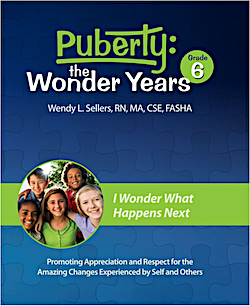Why We Need to Teach Puberty Education in 4-6
Avery has been missing a lot of school.
Riley touches and flirts with classmates resulting in frequent time outs.
Michaela often brings in notes to be excused from physical education class.
Logan was doing very well in school until grades and homework suddenly took a nosedive.
Madison is mocked and excluded by classmates.
Do these stories sound familiar? Sure they do. Have you considered teaching puberty education as a possible solution? Perhaps not, but let’s consider some of the reasons it’s important to teach fourth-, fifth- and sixth-graders about the amazing changes they will experience on their path through puberty and into adulthood.
The facts about puberty in the modern age
► Early puberty: Children are starting puberty earlier than in previous years. When they don’t know what to expect, these changes can be confusing and frightening.
► Sexualized society: Children swim in a sea of sexualized images and messages. Without the skills to decode these images and messages, they can act out in sexualized ways.
► Internet porn: When trusted adults don’t talk to children about their concerns and questions, they go to the internet for answers. This can lead children into websites with sexually explicit images, resulting in the formation of distorted or unrealistic expectations for relationships and behavior.
► Teamwork: Most parents of students did not receive a good sex education, so they might be at a loss for how to teach their children about puberty. Schools can work in partnership with parents to prepare their children for puberty and healthy relationships.
What is puberty education?
Puberty education focuses on the physical, social, emotional, and cognitive changes that every individual experiences as they transition from childhood to adulthood. It is a subset of sex education that is typically taught in grades 4, 5, and 6.
Traditionally, puberty education consisted of a one-hour session with a video shown in fifth grade in classes that separated boys and girls. Today’s puberty education teaches the information and skills modern students need to have a positive puberty experience.
These are some of the characteristics of best practice puberty education today:
- Curriculum with a planned scope and sequence is taught over two or three years. It’s not just a single-event session.
- Topics include issues that are relevant to students, such as friendships, consent, technology use, media literacy, and more.
- Lessons are developmentally appropriate for students at each grade.
- Lessons are inclusive so that all students can identify with the information being taught. This includes race, ethnicity, gender, orientation, ability, and socioeconomic class.
- Classes are taught in mixed-gender groups to avoid adding to the silence, shame, and stigma that is perpetuated by separating students by perceived gender.
- Teachers utilize trauma-informed strategies to teach puberty education to support students who have experienced trauma and avoid further trauma.
- Family engagement is an intrinsic part of the puberty education program.
Who should teach puberty education?
You might wonder who should teach puberty education. That answer depends on the laws in your state. For example, some states require sex education and others merely allow it. Some states have specific guidance about who is allowed to teach sex education. Other states leave it up to each school to decide.
If you are in a school with self-contained classes in grades four to six, the classroom teacher is the ideal person to teach these lessons. Sometimes, school nurses or school counselors are called upon to help.
In schools with a middle school model, health education, physical education, or science are the usual classes where puberty education is taught. If you are in a special education setting, you will want to modify and adapt the puberty education lessons to meet your students’ needs.
Teachers in grades four, five, and six might not feel prepared to teach puberty education, because they haven’t yet been equipped. Here are three keys to teaching puberty education with comfort, competence, and confidence:
- Professional Development: Workshops are available across the U.S. but might be difficult to access, depending on teachers’ location and allocation of resources. Online trainings are also available to provide practice of the skills needed to teach puberty education confidently.
- Teacher Standards: Professional Learning Standards provide guidance on the essential components needed to implement sex education.
- Curriculum: Having a teacher-friendly and student-engaging curriculum can also add to teachers’ comfort and confidence in teaching their students about puberty.
Helpful resources to get you started
Many resources are available to support teachers who want to teach puberty education in a way that helps their students navigate puberty in a positive manner.
- Recommended topics for grades 4-6 are outlined in the National Sex Education Standards.
- The “Guide to Trauma-Informed Sex Education” describes the components of a trauma-informed approach.
- The “Comprehensive Sex Education for Youth with Disabilities: A Call to Action” explains how to be inclusive of students with disabilities.
- Recommendations for inclusion of LGBTQ+ students can be found in “A Call to Action: LGBTQ Youth Need Inclusive Sex Education.”
- The “Principles of Gender-Inclusive Puberty and Health Education” show educators how to teach gender-inclusive puberty and health education.
About those students I introduced above
When teachers are prepared and equipped to implement quality puberty education, they are able to support students like Avery, Riley, Michaela, Logan, and Madison.

Logan’s school success could be impacted by sexual abuse or some other trauma. Madison would probably benefit from having some friends who respect and appreciate diversity. All these topics are included in quality puberty education.
Investing the time in teaching puberty education can reap many benefits. You will benefit from cultivating a more productive classroom climate and knowing you are meeting your students’ needs. Your students will benefit by learning the information and skills they need to stay safe and healthy now and into the future. Yes, puberty education deserves space in your instructional day!

Wendy loves to consult with schools and equip teachers to teach puberty education with resources, professional development, and technical assistance. Visit her website and follow her hashtag #LessShameMoreWonder







































